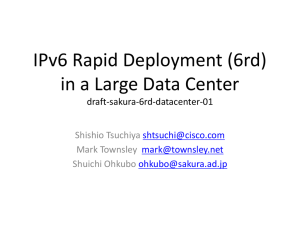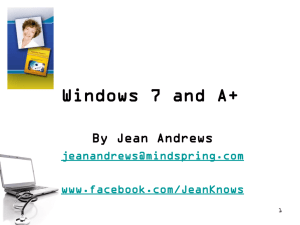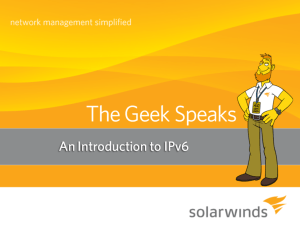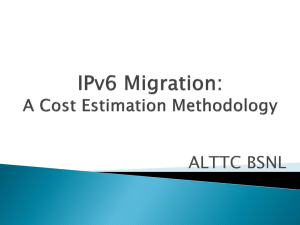6RD and IPv6 allocation policy
advertisement
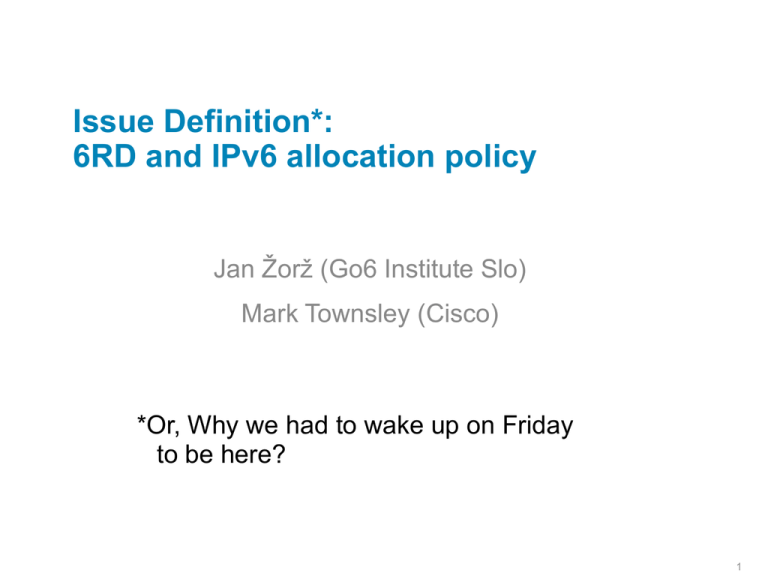
Issue Definition*: 6RD and IPv6 allocation policy Jan Žorž (Go6 Institute Slo) Mark Townsley (Cisco) *Or, Why we had to wake up on Friday to be here? 1 Aspects of IPv6 Transition Mechanisms Tunnel or Translate Stateless or Stateful SP-Managed or not SP-Managed 6rd is a Stateless, SP-Managed, Tunneling Protocol 2 IPv6 Prefix from an IPv4 Address The following construction is what allows 6rd to be SP-managed and Stateless 0 ISP 6rd IPv6 Prefix Subscriber IPv4 address 2001:db8 198.51.100.1 /n Subnet-ID /m Interface ID 64 Subscriber Delegated IPv6 Prefix 3 6rd – Encapsulation and Packet Flow “…externally 6rd looks, feels and smells like native IPv6 ” – RIPE Labs 6rd 6rd Dual Stack IPv4 Dual Stack Dual Stack Dual Stack 6rd Border Relays CE IPv4-only Access Network IPv6 in IPv4 (protocol 41) encapsulation Within a domain, IPv6 traffic follows IPv4 routing CEs reach BRs via IPv4 anycast 4 6rd – CE Provisioning 6rd 6rd Dual Stack IPv4 Dual Stack Dual Stack CE Dual Stack 6rd Border Relays Each 6rd CE within a 6rd Domain requires a single DHCP option* carrying 4 values 6rdPrefix 6rdPrefixLen IPv4MaskLen 6rdBRIPv4Address These 4 values are the same for all CEs within the domain *May also be configured with TR-69 or otherwise 5 6rd – Deployments 6rd 6rd Dual Stack IPv4 Dual Stack Dual Stack CE Dual Stack 6rd Border Relays Defined in RFC 5969 Commercially available products from a number of vendors First deployment in 2007, multiple deployments today 6 Q: What should /n and /m be? 0 ISP 6rd Prefix IPv4 (0-32 bits) 2001:db8 198.51.100.1 /n Subnet-ID /m Interface ID 64 7 Starting simple: /n = 28, /m = 60 ISP 6rd IPv6 Prefix 198.51.100.1 2001:db8 0 32 bits /28 Subnet-ID /60 Interface ID 64 One 6rd domain 6rd provisioning is identical for all CEs Convenient conversion between subscriber IPv6 and IPv4 address Allows 16 IPv6 subnets in the home ISP needs a /27 or shorter 8 But what if you cannot get a /27? /n = 32, /m = 64 32 bits ISP 6rd IPv6 Prefix 198.51.100.1 2001:db8 0 /32 Interface ID /64 Still a single domain, but /64 does not allow multiple subnets for the subscriber • No subnets, no routing • Common features such as Guest + Home SSIDs become very difficult • Support for 802.15.4 for Sensors, Zigbee, etc. • Ultimately leads to IPv6 NAT 9 Using less than 32 bits of IPv4 If the IPv4 space is an aggregate, 6rd need not carry the common bits For example, in a CGN world of 10/8, we just don’t carry around the 10 24 bits .51.100.1 2001:db8 0 /32 /56 /36 Interface ID 64 .51.100.1 2001:db80:0 0 Subnet-ID Interface ID /60 6 4 10 Multiple 6rd Domains ISP 6rd IPv6 Prefix IPv4 /12 32 bits 4 bits IPv4 /16 32 bits IPv4 /14 32 bits 4 bits IPv4 /11 32 bits 3 bits 8 bits Distinct IPv4 Aggregates 8 bits Interface ID (64 bits) 8 bits Interface ID (64 bits) 18 bits 8 bits Interface ID (64 bits) 19 bits 8 bits Interface ID (64 bits) 20 bits 16 bits More efficient in terms of IPv6 space usage However, CEs in different domains require different configuration Operations begin to get more complicated, traffic patterns not as efficient, etc. 11 How do I get my /27? "2^(48-(P+1))" "2^(48-(P+1)) + Growth" Growth -> 20% 10% 5% 0% Years -> 3 3 3 0 22 33,554,432 19,418,074 25,209,941 28,985,580 33,554,432 23 16,777,216 9,709,037 12,604,971 14,492,790 16,777,216 24 8,388,608 4,854,519 6,302,485 7,246,395 8,388,608 25 4,194,304 2,427,259 3,151,243 3,623,197 4,194,304 26 2,097,152 1,213,630 1,575,621 1,811,599 2,097,152 27 1,048,576 606,815 787,811 905,799 1,048,576 28 524,288 303,407 393,905 452,900 524,288 29 262,144 151,704 196,953 226,450 262,144 30 131,072 75,852 98,476 113,225 131,072 31 65,536 37,926 49,238 56,612 65,536 Prefix Size /27 yields /60 for the home /29 yields /62 for the home 12 Possible solutions 1. Declare this is a non-problem 2. Special 6rd policy. e.g., /27 granted based on ability and intention to deploy more rapidly with 6rd 3. Allow /29 to anyone 4. Others? 13
